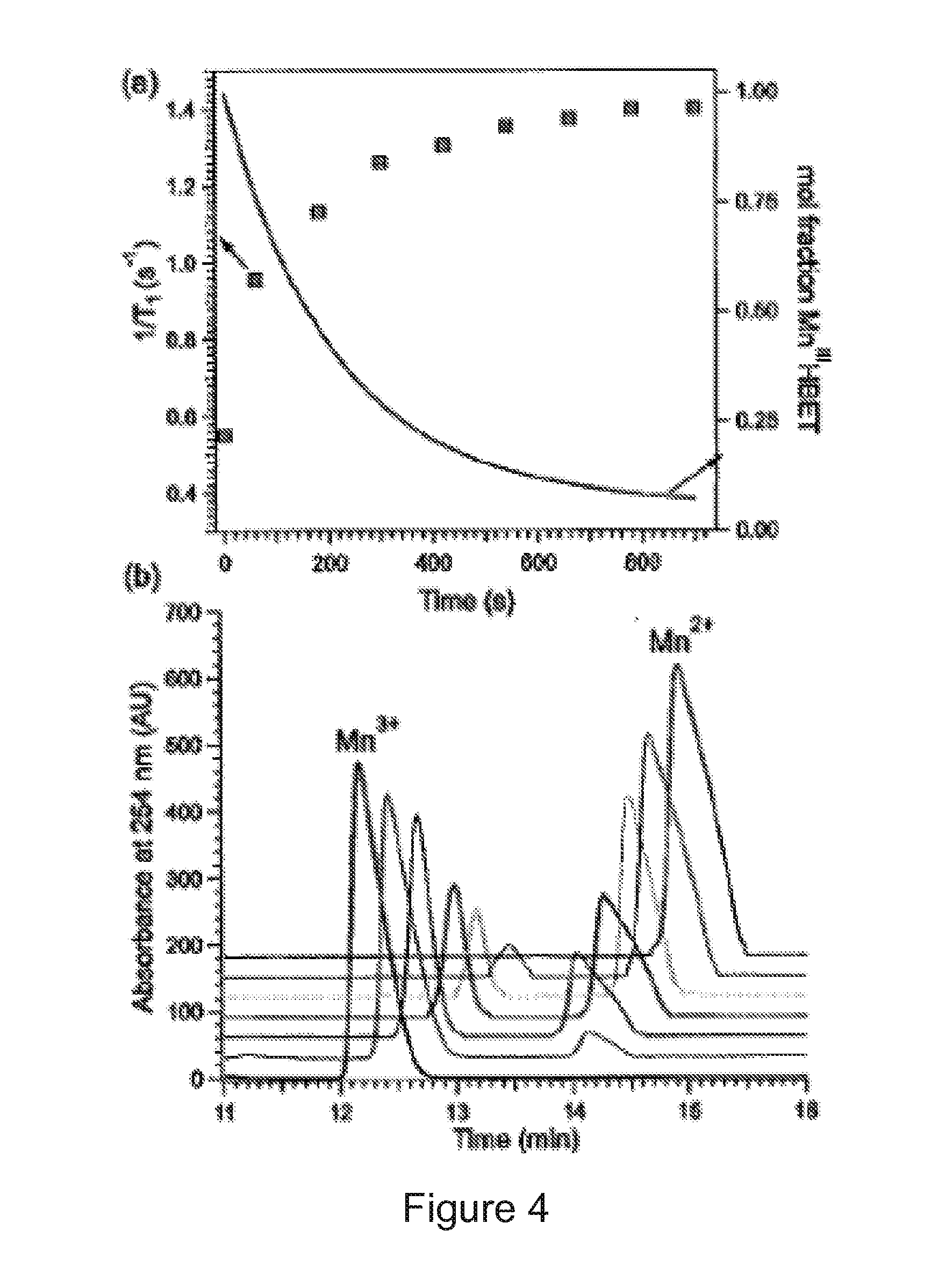Manganese-based magnetic resonance contrast agents
a magnetic resonance imaging and contrast agent technology, applied in the field of manganese-based magnetic resonance contrast agents, can solve the problems of insufficient vascularization, affecting the normal functioning of the affected area, so as to facilitate the preparation of dual mr-pet probes, facilitate the tumbling of molecules, and enhance the effect of mn(ii) relaxivity
- Summary
- Abstract
- Description
- Claims
- Application Information
AI Technical Summary
Benefits of technology
Problems solved by technology
Method used
Image
Examples
example 1
Experimental
General
[0119]Materials and Instrumentation. All chemicals and solvents were purchased commercially and used without further purification. NMR spectra were recorded on either 500 MHz or 400 MHz Varian spectrometers. Chemical shifts are reported in δ (ppm). For 1H and 13C NMR spectra, the residual solvent peaks were used as internal reference, except for the 13C NMR of the ligand where tertbutanol was used as the internal reference.
[0120]Liquid chromatography-electrospray mass spectrometry (LC-MS) was performed using an Agilent 1100 Series apparatus with an LC / MSD trap and Daly conversion dynode detector with UV detection at 220, 254 and 280 nm. The methods used on this system are as follows: (a) Luna C18 column (100×2 mm); eluent A: H2O / 0.1% formic acid, B: MeCN / 0.1% formic acid; gradient: 5% B to 95% B over 9 minutes; flow rate 0.8 mL / min (used for characterization of organic compounds), and (b) Kromasil C18 column (250×4.6 mm); eluent C: 95% MeCN / 5% 10 mM ammonium aceta...
example 2
Synthesis
[0178]A synthetic scheme for Example 2 can be found in FIG. 34.
[0179]N-tosyl diethylenetriamine (32). To a batch of 8.480 g (81.71 mmol) diethylenetriamine stirring in 120 mL MeCN at 0° C. was added 1.768 g (9.27 mmol) p-toluenesulfonyl chloride. A white heterogeneous solution formed instantly and the solution was warmed to room temperature and left to stir for 16 hours. The solution was subsequently concentrated to a white oil, taken up in 30 mL H2O, the pH adjusted to >10 and washed 2× with Et2O. The aqueous layer was then concentrated to a white residue via lyophilization. The resultant residue was taken up in 30 mL H2O and the pH adjusted to 7 via careful addition of trifluroacetic acid (TFA). The product was then purified via preparative HPLC using a Restek Ultra Aqueous C18 column (10 mm×250 mm); eluent A: H2O / 0.1% TFA, B: MeCN / 0.1% TFA; gradient 5% to 95% B over 23 minutes; flow rate: 5 mL / min. The fractions containing product were pooled and MeCN and TFA removed via...
example 3
Synthesis
[0184]Synthetic schemes for Example 3 can be found in FIGS. 38 and 39.
[0185]N-benzyl-1,2-diaminocyclohexane (36). To a batch of 7.113 g (62.29 mmol) 1,2-diaminocyclohexane in 50 mL MeCN was added dropwise 1.093 g (6.39 mmol) benzyl bromide in 10 mL MeCN at room temperature over the course of 1 hour. After 16 hours, the resultant white, heterogeneous solution was concentrated to dryness and partitioned between CH2Cl2 and satd. Na2CO3 (aq). The layers were separated and the organic phase washed again with satd. Na2CO3(aq) then brine, dried over Na2SO4 and concentrated to 1.280 g (6.26 mmol, 98%) of 36 as a light yellow oil. 1H NMR (500 MHZ, CDCl3, δ from TMS): 7.36-7.22 (m, 5H), 3.94 (d, 1H), 3.69 (d, 1H), 2.38 (m, 1H), 2.09 (m, 2H), 1.90 (m, 1H), 1.73 (m, 2H), 1.32-1.09 (m, 4H). ESI-MS: m / z=205 [M+H]+; calcd.: 205.3.
[0186]N′-benzyl-N′,N″,N″-tritbutylacetate-I,2-cyclohexylenediamine (37): To 1.133 g (5.55 mmol) 36, 4.194 g (32.35 mmol) diisopropylethylamine and 0.966 g (5.82 ...
PUM
| Property | Measurement | Unit |
|---|---|---|
| pH | aaaaa | aaaaa |
| pKa | aaaaa | aaaaa |
| pKa | aaaaa | aaaaa |
Abstract
Description
Claims
Application Information
 Login to View More
Login to View More - R&D
- Intellectual Property
- Life Sciences
- Materials
- Tech Scout
- Unparalleled Data Quality
- Higher Quality Content
- 60% Fewer Hallucinations
Browse by: Latest US Patents, China's latest patents, Technical Efficacy Thesaurus, Application Domain, Technology Topic, Popular Technical Reports.
© 2025 PatSnap. All rights reserved.Legal|Privacy policy|Modern Slavery Act Transparency Statement|Sitemap|About US| Contact US: help@patsnap.com



